

Gaming keyboard with DIY features: Asus ROG Azoth
The ROG Azoth is a half gaming, half DIY keyboard: macros and RGB lighting are just as important as its gasket-mount construction and hot-swap sockets. However, this first-class keyboard with its OLED screen costs almost as much as a custom model at 350 francs.
Mercury, or a precursor to the mythical Philosopher’s Stone – that’s what Azoth means. In fact, the ROG Azoth is something like a precursor to custom keyboards; my personal philosopher’s stone. The keyboard from Asus’ gaming brand is the best ready-to-use typing interface I’ve come across so far.

Scope of delivery and design: 75 per cent with neat inserts
The Azoth comes in the same branded box as all ROG products. Inside, it’s protected by a textile cover. Furthermore, various accessories are included in the scope of delivery, which usually aren’t found in prefabricated keyboards:
- Keycap and switch puller
- Switch opener
- A lubricant (Krytox 205G0)
- A brush to apply the lubricant
- A small lubrication station
- Three spare switches
- A coiled USB-A to USB-C cable
- An extender to amplify the signal of the 2.4 GHz dongle
Besides a cable, the Azoth can also be connected wirelessly via a 2.4 GHz dongle or Bluetooth. The battery is supposed to last for over 2000 hours with RGB lighting and the OLED screen turned off.
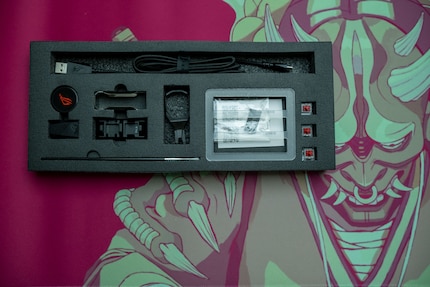
Source: Kevin Hofer
The keyboard itself comes in the 75 per cent form factor. Compared to a full-size keyboard, you do miss the number pad and a few navigation keys. Asus uses aluminium on the top and plastic on the bottom. According to the manufacturer, this is due to its wireless capability. If the whole keyboard were made of aluminium, it would affect signal quality.
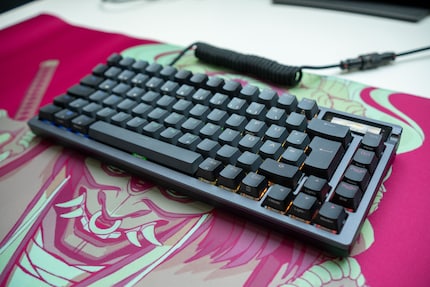
Source: Kevin Hofer
The top right sports an OLED display that can display varied information. Controls for the screen are located to its right, at the edge. The USB-C port, the dongle garage, and the toggle switch for selecting your connection mode are located on the rear. There’s also folding feet to change the angle of inclination in two steps on the bottom. Overall, the keyboard is very well manufactured.
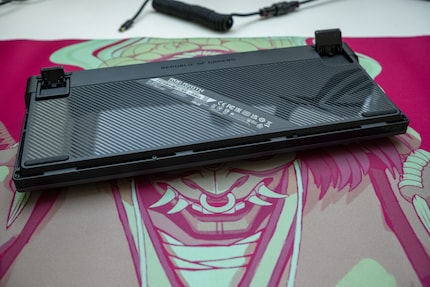
Source: Kevin Hofer
Pleasant typing, but not on a custom-made level
The ROG Azoth is a so-called gasket-mount keyboard. A cover plate, on which the switches are placed, is clamped between the lower and upper casing units with a rubber sealant, the so-called gaskets. This isolates the panel from the case, affecting both acoustics and the typing feel. Gasket-mount keyboards sound more muffled and are smoother to type on than conventional tray-mount keyboards. The cover plate and PCB are directly connected to the lower part of the case.
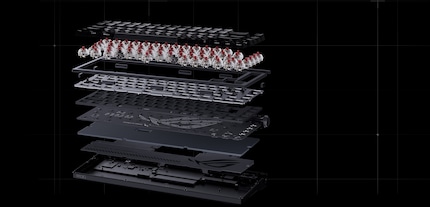
Source: Kevin Hofer
And I must say, the Azoth offers quite a pleasant typing experience. It isn’t quite as smooth as a Keychron Q1, but significantly better than a GMMK Pro. One reason for why it doesn’t come close to a Q1 is the fact that Asus relies on silicone instead of Poron for the seals. The former is a bit harder than the latter. Furthermore, the keyboard is stuffed with so much dampening material that it can’t yield as much when used.
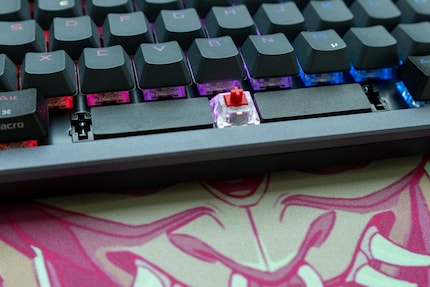
Source: Kevin Hofer
Sound-wise, the Azoth comes off as heavily muted. Asus has stuffed a 3.5-millimeter thick silicone pad between the steel cover plate and the PCB. In addition, there’s Poron foam and a silicone pad in the lower part of the case. The manufacturer even placed insulation pads underneath the space bar on the top plate.
Overall, I enjoy writing and gaming with the Azoth. I prefer an even softer typing feel, but for a gaming keyboard, it’s more than sufficiently soft and comfortable.
Stabilisers, switches and keycaps: amazingly effective
Asus relies on the same stabilisers – those things that support long keys like the space bar – as in other ROG keyboards. They’re home-made, with a fastening mechanism that’s unusual to me. Here’s what the looks like:
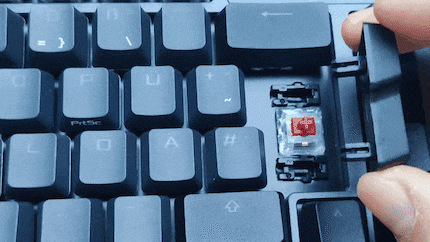
Source: Kevin Hofer
Asus has lubricated the stabilisers at all contact points. This eliminates nearly all rattling when used. Overall, they’re among the best I’ve come across in prefab keyboards. The stabilisers are attached to the cover plate. Among enthusiasts, those that attach directly to boards are preferred. Asus also offers this option, providing corresponding mounting holes on the board if you want to swap the stabilisers.
Asus also uses its own linear switches, namely the ROG NX Red. These trigger after 1.8 millimetres, requiring 45 grams of force. The total key drop comes distance to four millimetres, requiring 55 grams of force. They’re machine lubricated. I think the switches are fine. However, they feel and sound too scratchy for linear switches. But thanks to the included lubricant, I can still lend a hand and make them smoother. They’re easily removed thanks to hot-swap sockets. I just have to pull them out with the switch remover, no soldering needed.
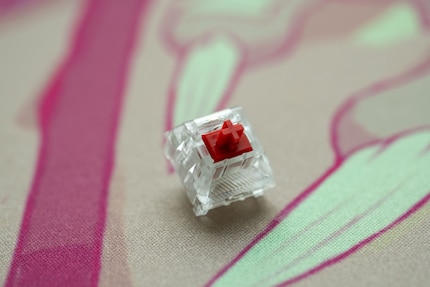
Source: Kevin Hofer
Once a switch is gone, fans of DIY keyboards might start complaining: RGB LEDs are attached to the upper part of the switch base. This usually leads to compatibility problems with Cherry keycaps, which aren’t tall enough. When you press a key, the keycap hits the switch case. In a different board, the stalks inside a switch would hit the bottom of the case. Surprisingly, I’ve no problem with Azoth’s keycaps, even though they sport a Cherry MX-like profile. Only GMK keycaps don’t fit.
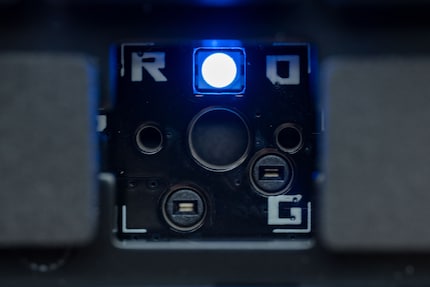
Source: Kevin Hofer
Since the Azoth is primarily a gaming and not a custom keyboard, this only plays a minor role. RGB lighting is vital in interfaces. And RGB LEDs always look better placed in the upper part of the switch base. There are labels on the keycaps, making them better illuminated.
Hey, let’s talk about the keycaps. Unlike the ROG Claymore II, these are Cherry MX compatible. This means you’ll find a variety of compatible keycaps for the switches. The layout of the keyboard is also standardised. Thus, it’s easy to switch keycaps should you wish to do so.
The keycaps themselves are made of PBT plastic – at least on my test device sporting a DE layout. A Swiss layout for the keyboard isn’t in the works for the time being. The primary inscriptions are made using double injection moulding. As a result, they should never fade. The second and third functions are printed. With an average thickness of 1.35 millimetres, these keycaps are strong enough and also look generally well made. Personally, though, I’m not a fan of the font. As is common among gaming keyboards, it’s just too childish for my tastes.

Source: Photo by Kevin Hofer
OLED and other features
The coolest feature of the keyboard is its OLED screen. It can be personalised with the Armoury Crate software. You can set animations, create them yourself, or even display system-relevant information like CPU temperature. Pity that the screen is just too wide. Some pictures just won’t fit.

Source: Kevin Hofer
Use the button on the side of the panel to switch between options. You activate and/or change multimedia controls, lighting and OLED brightness, lighting effects and volume. Use the slider above to confirm settings. The screen isn’t touch-compatible. Compared to the rest of the keyboard, the knob and slider fall short. They feel cheap when I press them, rattling and clattering. I doubt they’ll last long.
In the software, as is usual for gaming keyboards, key assignments, macros and RGB lighting can be changed. You can also browse power settings or update the firmware. Personally, I don’t enjoy the application much. It’s too cluttered and overloaded for me.
Other features include connections to up to three devices simultaneously, on-the-fly macro recording, onboard memory for up to six profiles, and macOS support.
A successful fusion of DIY and gaming features
The ROG Azoth manages the balancing act between gaming and custom keyboards well. Features such as low-latency wireless, macro programming and RGB lighting are no doubt gaming influences. Gasket-mount construction, easy modding options and the scope of delivery including a lubricant will make fans of custom keyboards jump with joy.
Furthermore, the keyboard is very well manufactured and offers a cool feature in the OLED screen. My only major point of criticism is the screen’s knob and slider. They simply aren’t on the same level as the rest of the keyboard and feel cheap.
If you’re already in the custom keyboard game, I can’t recommend the Azoth. It’ll leave you wanting in crucial places. But if you’re a gamer and want to get a taste of DIY without jumping in the deep end, the Azoth might be for you.
Consequently, its target group is likely pretty small And that’s exactly the point: Asus probably doesn’t expect to sell many units, setting the price relatively high. 350 francs is too much in my eyes. With the large number of keyboards Asus can produce at a time, the price should really be somewhere between 270 and 300 francs.
From big data to big brother, Cyborgs to Sci-Fi. All aspects of technology and society fascinate me.


